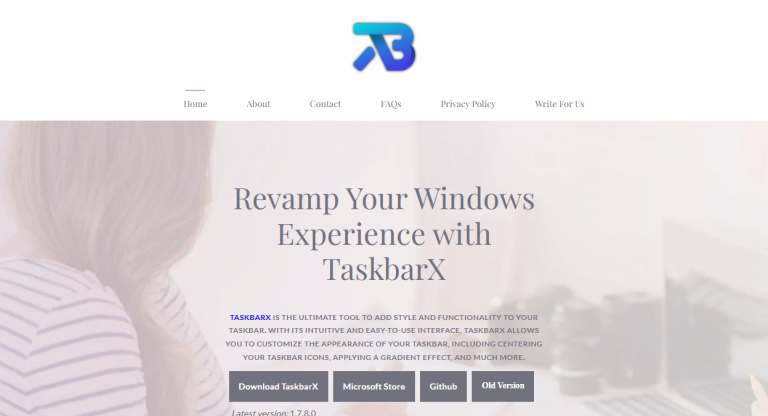Windows users have always looked for ways to make their desktop truly theirs. Themes, wallpapers, icon packs — customization options are endless. But when it comes to the Windows taskbar, Microsoft offers limited flexibility out of the box. That’s where tools like TaskbarX step in, unlocking aesthetic and functional upgrades that make the desktop not just personal, but powerful.
Among dozens of customization apps, TaskbarX stands tall. It’s sleek, lightweight, open-source, and focused entirely on transforming your taskbar’s behavior and appearance. But what truly sets it apart?
Let’s explore the deeper features, advantages, and usability aspects that make TaskbarX not just another utility, but the top choice for users serious about taskbar customization.
Born From a Need for Simplicity and Control
Many tools offer extensive tweaks for Windows UI — from complete shell replacements to advanced registry hacks. However, they often come at a cost: bloated software, steep learning curves, or system instability.
TaskbarX focuses on one thing: giving you full control over your taskbar layout, animations, and position — without overcomplicating the experience. Created by Chris Andriessen, TaskbarX emerged from the open-source community with one mission: make Windows taskbars modern, minimal, and customizable.
That laser-sharp focus on simplicity and functionality is its first major win over other tools.
Centered Icons That Just Work
Before Windows 11 came along with centered taskbar icons by default, users relied on hacks and third-party tools to mimic that macOS-like alignment. While several programs tried to do it, most were clunky or inconsistent.
TaskbarX delivers perfectly centered icons on the taskbar — even with dynamic changes like launching new apps or closing windows. It doesn’t fake the center; it dynamically repositions icons in real-time with pixel-perfect accuracy.
No matter your screen resolution or number of monitors, the icons remain beautifully centered. Competing tools often struggle with dual-monitor setups or taskbar overflow — TaskbarX doesn’t flinch.
Smooth Animations and Transitions
Where most customization apps stop at static alignment or color tweaks, TaskbarX goes a step further with fluid animations.
Whether you’re opening, closing, or switching applications, TaskbarX animates icon movement with smooth transitions that feel native. You can choose from various animation styles — ease-in, slide, bounce, fade — all adjustable in duration and speed.
It’s subtle but powerful. These transitions create a user experience that feels modern, polished, and intentionally designed. For users who spend hours at their PCs, that level of polish matters more than people might think.
Deep Customization Without Bloat
TaskbarX delivers a robust feature set in a surprisingly compact package — under 5MB. No background telemetry, no bundled add-ons, and no hidden services.
From its minimalist control panel, users can adjust:
- Taskbar color and transparency
- Icon alignment and spacing
- Animation type and speed
- Startup behavior
- Edge cases for multi-monitor setups
Unlike bloated customization suites that try to do too much — skins, widgets, app launchers — TaskbarX avoids feature creep. It’s focused, clean, and doesn’t weigh down your system.
Works Across Windows Versions
Many taskbar tools break after Windows updates. Not TaskbarX.
It works flawlessly across multiple versions: Windows 10, Windows 11, and even older systems like Windows 8. The developer community regularly tests TaskbarX against new Windows builds, ensuring compatibility.
And while Windows 11 introduced centered icons, TaskbarX offers a more advanced version of the feature. Want to center only certain icons? Want dynamic adjustments based on how many apps are open? TaskbarX handles that. Windows 11’s default settings don’t.
Fully Offline, No Ads or Subscriptions
In a world where many customization apps have gone the route of subscriptions, TaskbarX remains 100% free and offline. There’s no need to sign up, register, or watch ads. The full software is available on GitHub or via the Microsoft Store (for a small donation).
This alone sets it apart from many “freemium” tools that limit basic features unless you upgrade or share personal data. TaskbarX’s open-source nature gives users confidence — no hidden code, no surprises.
Light on Resources, Heavy on Performance
TaskbarX runs in the background as a lightweight process. On modern systems, it consumes less than 1% CPU and negligible memory. For users who game, edit videos, or run virtual machines, this is crucial.
Compare that to all-in-one customization tools that load dozens of services at startup, and you’ll see why TaskbarX has a loyal fanbase. It enhances your desktop without sacrificing performance.
Actively Maintained with a Strong Community
The open-source nature of TaskbarX means continuous improvements from a passionate developer base. Issues are tracked on GitHub, and updates roll out frequently. Users can suggest features, report bugs, or even fork the project.
Most paid tools have slow update cycles and limited community involvement. TaskbarX, on the other hand, thrives on transparency and user-driven innovation.
Portable and Easy to Uninstall
Not every user wants permanent modifications to their system. TaskbarX is portable — no installation required. You can run it from any folder, USB stick, or even a cloud-synced drive.
If you ever want to remove it, just delete the files. No registry changes, no residual files. This makes it perfect for advanced users, IT professionals, and those who frequently switch systems.
Aesthetic Control for Minimalists
For fans of minimal desktop setups, TaskbarX is a dream. You can hide the taskbar background entirely, set dynamic transparency, or use blur effects for a futuristic look.
Combine it with minimalist wallpapers and icon packs, and your Windows setup becomes unrecognizably clean — more like a Linux desktop or macOS dock than traditional Windows UI.
Most alternatives either don’t offer this level of control or require multiple tools to achieve the same result.
Comparisons with Popular Alternatives
To understand what makes TaskbarX superior, it helps to compare it directly with other popular tools:
| Feature | TaskbarX | StartIsBack | RocketDock | Rainmeter |
| Centered Taskbar Icons | ✅ | ❌ | ❌ | ❌ |
| Custom Animations | ✅ | ❌ | ❌ | ❌ |
| Transparency Effects | ✅ | Limited | ❌ | ✅ |
| Lightweight and Portable | ✅ | ❌ | ✅ | ❌ |
| Free and Open Source | ✅ | ❌ | ✅ | ✅ |
| Frequent Updates | ✅ | ❌ | ❌ | ✅ |
| Full Offline Support | ✅ | ❌ | ✅ | ✅ |
While tools like Rainmeter and RocketDock offer visual customization, they don’t touch the taskbar functionality the way TaskbarX does. And while StartIsBack or similar shell tools give system-wide UI tweaks, they often complicate things with heavy integrations.
Real-World Use Cases
- Gamers love TaskbarX for keeping icons clean, centered, and distraction-free.
- Designers use it to match their taskbar to themed workspaces or wallpapers.
- Streamers enjoy the dynamic animations that make task switching feel fluid during broadcasts.
- Corporate users quietly deploy it to clean up multi-monitor setups without risking system conflicts.
Wherever people care about a clean, intuitive desktop — TaskbarX delivers.
Ideal for Beginners and Power Users
You don’t need to know coding or registry editing to use TaskbarX. The user interface is beginner-friendly, but if you want advanced configurations, you can dig into the config files or even automate with PowerShell.
Most alternatives lean heavily one way — either too simplistic or too technical. TaskbarX strikes the perfect balance.
The Verdict: Why TaskbarX Wins
When looking at the full landscape of Windows customization tools, TaskbarX stands out by doing one thing exceptionally well: transforming your taskbar into a beautiful, centered, animated, and lightweight hub.
It avoids unnecessary features, stays lean, and remains completely user-first. Whether you’re a creative professional, a gamer, or just someone who likes a cleaner desktop, TaskbarX has you covered.
Its open-source nature, active development, and unmatched customization controls make it a top-tier choice in desktop enhancements.
Final Thoughts
TaskbarX doesn’t just compete — it leads the pack. With its minimal impact, deep feature set, and sleek performance, it’s clear why so many Windows users swear by it.
Customization should enhance your workflow, not hinder it. That’s the philosophy behind TaskbarX — and the reason it remains a go-to tool for users seeking true taskbar control without compromise.

